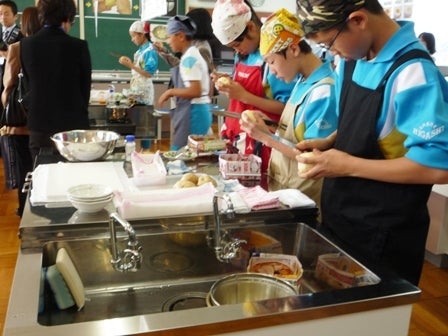I have never had questions about why Japanese Elementary Schools have certain facilities, such as swimming pools, science group tables with running water, sink, and gas burner access, and home-economic group tables converted between cooking (running water, sink, and gas table top) and sewing and craft, because they have been always available when needed throughout my twelve years of public education plus my teaching career in various regions of Japan.
"Where is the swimming pool?" It was the first question I asked in the Elementary School where I interned in Idaho. This teacher looked at me like a crazy person, "We don't have any. Did you have one in your school?" I replied hesitantly, "Most of the public Elementary Schools have their own swimming pool in Japan. Our school had one on the rooftop of a three story school building." I have learned that while swimming is a P.E. requirement in Japan, it isn't in the U.S. Elementary Schools in Japan rarely have a "P.E Specialist". Classroom teachers mostly teach P.E, music, science (in most/many cases) and home economies (in 5th and 6th grade). I also learned that, thus, American teachers don't have to go through a swimming test during their job application/hiring process.
During the school tour, I noticed a couple of my favorite rooms were missing although I found the music room. The science room and the home economics room were gone.
The science room was full of excitement. We divided water into oxygen and hydrogen. We timed how long candle lights last in different sizes of jars. We observed how litmus' change its colors. It was absolutely joyous when we confirmed our predictions through meaningful and hands on experiments. Collaborative effort was also heavily involved in the process. There have always been more than enough scientific equipments inside of the locked cupboard in the science prep room.
The home economics is another unique academic requirement in 5th and 6th grade.
Both boys and girls get to cook "real" food in the home economics room. There is the lesson about the nutrition and cooking process on the group table a week before the cooking day. Then, students slide the wooden surface over, and wallah! The convenient cooking table, sink, and stove top appear! From the preparation to the final cleaning, there are no food scraps nor even a single drop of water on the counter top. Students are evaluated not only on participation, but on their skills of organization as well as their actual cooking.
Other times, kids learn hand and machine sewing on the same tables in the room with the wooden surfaces.
As you can see, the home economic room is well designed functionally. In addition to a knowledge assessment on paper, students sewing skill's are assessed by their finished products based on the consistency of the stitch size, creativity of their product, neatness, etc. Though the assessment part was not my favorite part (whose was it?), creating new culinary arts and sewing related crafts was always rewarding after hard work and teamwork.
I wish we could have these useful facilities and extra curriculum in the U.S schools that motivate students to want to learn more. These are life skills which they can apply in their future life. I call it "Life Readiness", if not college/career readiness.




No comments:
Post a Comment